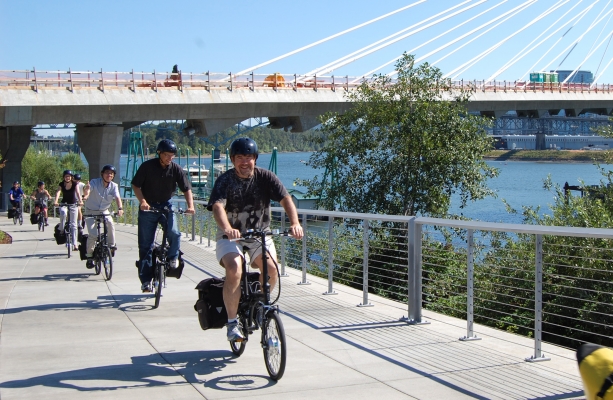E-bikes may be the key to increasing cycling in America

Evaluation of Electric Bike Use at Three Kaiser Permanente NW Employment Centers in Portland Metro Region
John MacArthur, Portland State University; Jennifer Dill, Portland State University
Despite efforts to get more people biking, North America still has low ridership numbers. The problem? Biking is hard.
A new report by John MacArthur of Portland State University's Transportation Research and Education Center (TREC), funded by the National Institute for Transportation and Communtiies, offers a solution to that problem: e-bikes.
Many people surveyed say that having to pedal up hills and arriving at their destination sweaty are major deterrents to commuting by bike, even when bike lanes and other facilities are there.
Researchers have put a lot of thought into ways to get more people riding bicycles by improving bicycle infrastructure, land use and public engagement. The efforts are largely due to concerns about congestion, climate change and public health. Comparatively little research, however, has focused on the bicycle itself.
MacArthur and co-investigator Jennifer Dill teamed up with Drive Oregon, Metro and Kaiser Permanente Northwest to provide Kaiser employees with electric-assist bicycles (e-bikes) to use for a trial period of ten weeks. The goal was to see if e-bikes might help overcome some commonly cited barriers to cycling. The study, Evaluation of Electric Bike Use at Three Kaiser Permanente NW Employment Centers in Portland Metro Region, took place in Portland, Oregon from April 2014 to September 2015:
- A total of 150 Kaiser employees participated in the study.
- Fewer than 10% of them had ever ridden an e-bike as an adult, and 50% of them said that they normally never rode a bike at all.
- Half the participants fit into the "interested but concerned" category in Roger Geller’s typology of bicyclists—the category seen as key to increasing cycling rates.
 Provided by local dealer Bike N Hike, each person was given a Currie iZip E3 e-bike to take home: a 42-pound bicycle with a rear rack-mounted battery pack, capable of doing 18 mph (29 kph) under motor assist. They could use it however they wanted during the 10-week period.
Provided by local dealer Bike N Hike, each person was given a Currie iZip E3 e-bike to take home: a 42-pound bicycle with a rear rack-mounted battery pack, capable of doing 18 mph (29 kph) under motor assist. They could use it however they wanted during the 10-week period.
Researchers sought to find out if having the e-bikes would encourage participants to cycle more. “For certain segments of the population there is lower participation in cycling, particularly women, older adults and people with physical limitations," MacArthur said. "E-bikes could get more people biking and biking more often."
The Kaiser volunteers in this study—over half of whom were women—were asked to take online surveys before, during, and after the study.
- The pre-use survey collected data on their demographics, their attitudes toward biking, and their typical travel habits.
- During the study, there were questions about how they were using the e-bikes and their impressions of the experience.
- The post-use survey asked questions about attitudes and travel habits similar to the first survey, now that the participants had used the e-bikes.
Before beginning the program, 38% of respondents were categorized as “strong and fearless” or “enthused and confident" using Geller's typology. After using an e-bike, 52% were categorized as such.
Researchers compared the barriers participants faced before and after the program and found some notable shifts in attitudes and behaviors:
- The number of people commuting to work by bicycle at least once a week more than doubled during the study.
- The second most common use of the e-bikes was for personal trips. The number of people biking at least once a month for shopping or other errands doubled when they had access to the e-bikes, and those biking to visit friends or family at least once a week more than quadrupled.
- A majority of the respondents – 64% – said they were likely to ride the e-bike purely for exercise or fun. This analysis shows that people will use a bicycle more if it is electric assist.
- About 85% of respondents had access to a functional bicycle before the program, yet only 23% reported using a bicycle once per week or more. During the program, this rate became 53%, in part because the e-bikes made people feel more confident riding.
In Portland, e-bikes can use the same facilities that are intended for regular bikes – bike lanes, multi-use paths and greenways – as well as riding in the lane with on-road traffic. That’s not true everywhere. In 2014, MacArthur and Nick Kobel, an associate economic planner with the city of Portland who at the time was a Portland State University graduate student, conducted a comprehensive review of the different regulations of e-bikes in North America; a useful resource for anyone interested in adopting or advocating for e-bikes.
